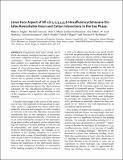Files in this item
Janus face aspect of all-cis 1,2,3,4,5,6-hexafluorocyclohexane dictates remarkable anion and cation interactions in the gas phase
Item metadata
| dc.contributor.author | Ziegler, Blake | |
| dc.contributor.author | Lecours, Michael | |
| dc.contributor.author | Marta, Rick | |
| dc.contributor.author | Featherstone, Joshua | |
| dc.contributor.author | Fillion, Eric | |
| dc.contributor.author | Hopkins, W. Scott | |
| dc.contributor.author | Steinmetz, Vincent | |
| dc.contributor.author | Keddie, Neil Steven | |
| dc.contributor.author | O'Hagan, David | |
| dc.contributor.author | McMahon, Terrance | |
| dc.date.accessioned | 2017-05-05T23:33:52Z | |
| dc.date.available | 2017-05-05T23:33:52Z | |
| dc.date.issued | 2016-06-22 | |
| dc.identifier | 242548042 | |
| dc.identifier | bc316db1-7d7b-424d-9e59-6e6ee494594b | |
| dc.identifier | 84976385281 | |
| dc.identifier | 000378584600005 | |
| dc.identifier.citation | Ziegler , B , Lecours , M , Marta , R , Featherstone , J , Fillion , E , Hopkins , W S , Steinmetz , V , Keddie , N S , O'Hagan , D & McMahon , T 2016 , ' Janus face aspect of all- cis 1,2,3,4,5,6-hexafluorocyclohexane dictates remarkable anion and cation interactions in the gas phase ' , Journal of the American Chemical Society , vol. 138 , no. 24 , pp. 7460-7463 . https://doi.org/10.1021/jacs.6b02856 | en |
| dc.identifier.issn | 0002-7863 | |
| dc.identifier.other | ORCID: /0000-0002-9502-5862/work/35745200 | |
| dc.identifier.other | ORCID: /0000-0002-0510-5552/work/68281226 | |
| dc.identifier.uri | https://hdl.handle.net/10023/10715 | |
| dc.description | The authors acknowledge support in the form of NSERC (Canada) Discovery Grants to EF, WSH, and TBM and an EPSRC (UK) responsive mode grant to DO’H and NSK is gratefully acknowledged. | en |
| dc.description.abstract | Experiments have been carried out in which electrospray ionization has been used to generate ionic complexes of all-cis 1,2,3,4,5,6 hexafluorocyclohexane. These complexes were subsequently mass isolated in a quadrupole ion trap mass spectrometer and then irradiated by the tunable infrared output of a free electron laser in the 800-1600 cm−1 range. From the frequency dependence of the fragmentation of the complexes, vibrational signatures of the complexes were obtained. Computational work carried out in parallel reveals that the complexes formed are very strongly bound and are among the most strongly bound complexes of Na+ and Cl− ever observed with molecular species. The dipole moment calculated for the heaxafluorocyclohexane is very large (~7 D) and it appears that the bonding in each of the complexes has a significant electrostatic contribution. | |
| dc.format.extent | 1708802 | |
| dc.language.iso | eng | |
| dc.relation.ispartof | Journal of the American Chemical Society | en |
| dc.subject | QD Chemistry | en |
| dc.subject | NDAS | en |
| dc.subject | BDC | en |
| dc.subject.lcc | QD | en |
| dc.title | Janus face aspect of all-cis 1,2,3,4,5,6-hexafluorocyclohexane dictates remarkable anion and cation interactions in the gas phase | en |
| dc.type | Journal article | en |
| dc.contributor.sponsor | EPSRC | en |
| dc.contributor.sponsor | EPSRC | en |
| dc.contributor.institution | University of St Andrews. School of Chemistry | en |
| dc.contributor.institution | University of St Andrews. EaSTCHEM | en |
| dc.contributor.institution | University of St Andrews. Biomedical Sciences Research Complex | en |
| dc.identifier.doi | 10.1021/jacs.6b02856 | |
| dc.description.status | Peer reviewed | en |
| dc.date.embargoedUntil | 2017-05-05 | |
| dc.identifier.url | https://pubs.acs.org/doi/suppl/10.1021/jacs.6b02856 | en |
| dc.identifier.grantnumber | EP/H022651/1 | en |
| dc.identifier.grantnumber | EP/L017911/1 | en |
This item appears in the following Collection(s)
Items in the St Andrews Research Repository are protected by copyright, with all rights reserved, unless otherwise indicated.

